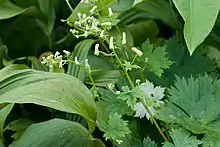Gigactonine
Gigactonine is a naturally occurring diterpene alkaloid first isolated from Aconitum gigas. It occurs widely in the Ranunculaceae plant family. The polycyclic ring system of this chemical compound contains nineteen carbon atoms and one nitrogen atom, which is the same as in aconitine and this is reflected in its preferred IUPAC name.
 | |
| Names | |
|---|---|
| IUPAC name
(1α,6β,14α,16β)-20-Ethyl-4-(hydroxymethyl)-6,14,16-trimethoxyaconitane-1,7,8-triol | |
| Identifiers | |
3D model (JSmol) |
|
| ChemSpider | |
PubChem CID |
|
CompTox Dashboard (EPA) |
|
| |
| |
| Properties[1] | |
| C24H39NO7 | |
| Molar mass | 453.576 g·mol−1 |
| Melting point | 168 °C (334 °F; 441 K) |
Except where otherwise noted, data are given for materials in their standard state (at 25 °C [77 °F], 100 kPa). | |
| Infobox references | |
History

Gigactonine was reported in 1978 after its isolation from Aconitum gigas. Although a novel structure at that time, it was recognised to be related to known diterpene alkaloids including delsoline, which is methylated on its 4-hydroxymethyl primary alcohol sidechain.[1]
Synthesis
Although individual members of this class of alkaloids have been extensively studied, their chemical complexity has limited the number which have been individually synthesised. Similarly, their full biosynthetic pathway is only known in outline in most cases.[2]
Natural occurrence
Gigactonine has been reported as the main alkaloid in the flowers of Aconitum lycoctonum[3] and has been isolated from Delphinium[4] including Delphinium ajacis[5] and other Consolida species in the Ranunculaceae plant family.[6]
Biochemistry
Compounds related to aconitine are widely studied for their properties in biological systems and these have been reviewed.[6] For example, gigactonine has been reported to have hERG-inhibiting activity.[7]
External links
- Sakai, S.; Shinma, N.; Hasegawa, S.; Okamoto, T. (1978). "On the Alkaloids of Aconitum gigas Lev. et Van. and the structure of a New Base, Gigactonine". Yakugaku Zasshi. 98 (10): 1376–1384. doi:10.1248/yakushi1947.98.10_1376.
- Cherney, Emily C.; Baran, Phil S. (2011). "Terpenoid-Alkaloids: Their Biosynthetic Twist of Fate and Total Synthesis". Israel Journal of Chemistry. 51 (3–4): 391–405. doi:10.1002/ijch.201100005. PMC 4508874. PMID 26207071.
- Chen, Ying; Katz, Alfred (1999). "Isolation of Norditerpenoid Alkaloids from Flowers of Aconitum lycoctonum". Journal of Natural Products. 62 (5): 798–799. doi:10.1021/np980576q. PMID 10346976.
- Yin, Tianpeng; Cai, Le; Ding, Zhongtao (2020). "An overview of the chemical constituents from the genus Delphinium reported in the last four decades". RSC Advances. 10 (23): 13669–13686. doi:10.1039/D0RA00813C.
- Pelletier, S. William; Bhandaru, Sudhakar; Desai, Haridutt K.; Ross, Samir A.; Sayed, Hanna M. (1992). "Two New Norditerpenoid Alkaloids from the Roots of Delphinium ajacis". Journal of Natural Products. 55 (6): 736–743. doi:10.1021/np50084a005.
- Yin, Tianpeng; Cai, Le; Ding, Zhongtao (2020). "A systematic review on the chemical constituents of the genus Consolida (Ranunculaceae) and their biological activities". RSC Advances. 10 (58): 35072–35089. doi:10.1039/D0RA06811J.
- "Diterpene alkaloids from Aconitum anthora and assessment of the hERG-inhibiting ability of Aconitum alkaloids" (PDF). Planta Med. 77: 368–73. 2011. doi:10.1055/s-0030-1250362. PMID 20862641.